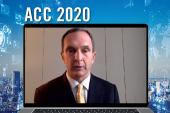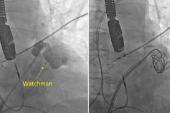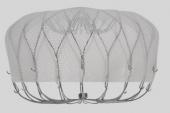RF-Based Energy Closes Residual Leaks After Watchman Implantation
The procedure might help patients avoid anticoagulation again, but there are still questions about which leaks to go after.

Applying radiofrequency (RF) energy to the left atrial appendage (LAA) in patients with residual leak after Watchman (Boston Scientific) implantation might be a viable way to eliminate peridevice leakage, according to the results of a small, prospective study.
In 43 patients with a residual leak of 4 mm or greater in diameter, the use of RF energy was effective at completely sealing the LAA in 23 patients, while it was largely effective in another 15 patients who had just mild or minimal leaks of 1-2 mm after the electrophysiology (EP) procedure.
Prior studies, including follow-up from the PROTECT-AF study, suggest that residual leaks can occur in as many as one-third of cases. Lead investigator Domenico Della Rocca, MD (The Texas Cardiac Arrhythmia Institute/St. David’s Medical Center, Austin), said the newest-generation Watchman FLX is much better than the older devices at minimizing its occurrence. Still, the rate of significant leak—defined as 5 mm or greater—ranges from 1% to 4% depending on the anatomy and the operator’s experience.
The biggest concern with residual leak is the ensuing risk of thromboembolism from the LAA. “That is why there is a lot of work on optimizing the technique to clearly reduce the risk of leak when treating these patients and, when there is some leak during follow-up, to provide [physicians] with some tools to treat those leaks instead of using oral anticoagulation,” Della Rocca told TCTMD.
Subramaniam Krishnan, MD (Sutter Heart and Vascular Institute, Sacramento, CA), who along with Andrea Natale, MD (The Texas Cardiac Arrhythmia Institute/St. David’s Medical Center), conceived of applying RF energy to the atrial appendage tissue at the site of the leak, said operators are looking to “injure” the endothelium with the application of RF energy because “injuring the endothelium seems to result in adhesions between the neighboring structures.”
The results were published July 27, 2021, in JACC: Electrophysiology and presented at the Heart Rhythm Society 2021 Scientific Sessions.
Not Comfortable Leaving Leaks Behind
Della Rocca said they have been working on developing alternatives to restarting anticoagulation in patients with large residual leak. In the past, they have published data showing that transcatheter embolization coils can close leaks after LAA occlusion/closure procedures. He noted that several years ago their group, with Krishnan as senior author, published a feasibility study showing that injuring the opposing surfaces of the septum primum and septum secundum with RF energy could close patent foramen ovale.
“We thought: why don’t we apply the same concept to leaks?” said Della Rocca. Krishnan noted that RF ablation has also been shown to be effective in reducing leaks with detachable endovascular coils in the setting of intracranial aneurysms.
In the prospective study, patients undergoing a redo catheter ablation for atrial fibrillation and with evidence of significant residual LAA leaks (≥ 4 mm) after Watchman 2.5 or FLX were eligible for inclusion. RF-based closure of the leak was attempted either at the time of percutaneous LAA closure or scheduled after documentation of incomplete closure on follow-up transesophageal echocardiography (TEE). The procedure, which involved targeting the atrial side of peridevice leak using an irrigated-tip ablation catheter, was performed by six operators at four US centers.
Nearly half of study participants (44.2%) had incomplete LAA closure after acute deployment of the device, while residual leak was documented at the time of routine TEE follow-up in the remaining patients. On average, the procedure involved 18 RF energy applications, the mean duration of each being 17 seconds. It took roughly 30 minutes to perform.
Acute success was confirmed in all patients. During a mean follow-up of 48 days, 53.5% had complete LAA sealing, 34.9% had mild or minimal leaks, and 11.6% had moderate leaks. The long-term success rate—defined as complete LAA occlusion or presence of mild or minimal peridevice leak on follow-up TEE—was 88.4%. There were no cases of device dislodgement, embolization, or thrombosis. Overall, the procedure was considered safe, with just one case of pericardial effusion reported in the multicenter study.
Hussam Suradi, MD (Rush University Medical Center, Chicago, IL), who wasn’t involved in the study, said the novel application of RF energy to close residual leaks is promising, but also noted that the field, particularly the treatment of residual leak, is still in its infancy.
“They had high success rates and it’s a relatively safe procedure, but it’s very early,” Suradi told TCTMD. “It would be nice to see a larger number of patients, as well as a randomized trial of leak closure versus conservative therapy to see what we’re doing. By going after these leaks, are we changing anything? Are we improving their outcomes? Are we minimizing the risk of stroke in these patients?”
Big Leaks and Little Leaks
At the moment, the association between residual leak with the Watchman device and thromboembolic events is poorly understood, said Krishan, but there is evidence showing that incomplete closure with the Lariat device (SentreHEART) or surgical exclusion is associated with an increased risk of subsequent stroke—raising concerns that the Watchman might suffer the same problems. Della Rocca said there is some uncertainty about the stroke risks for leaks with a diameter of 3 to 4 mm, although there are data showing leaks of this size do pose a risk of thromboembolism. In common practice, 5 mm is the arbitrary cutoff for deciding whether or not to start oral anticoagulation.
“As a physician, in spite of what the clinical trials and registries show, it is very difficult to feel comfortable stopping anticoagulation in patients,” said Krishnan. “For the Watchman and other devices like this to become mainstream, it has to jump across more hurdles. If you know for a fact there are no adjacent gaps and that there is a good solid covering of the device with a layer of neointima and endothelium, you’re going to feel a lot more comfortable stopping anticoagulation. And that’s the reason the device was developed in the first place.”
Suradi, who wasn’t involved in the study, said that while residual leak was not associated with poor outcomes in the PROTECT-AF study, the number of patients with large residual leak was small in that subanalysis, he said.
“We worry about [leaks], and we worry patients aren’t protected adequately,” he said. “They’re not on anticoagulation, and there is a worry that the leak can lead to thrombus formation and that can eventually lead to stroke. But do we have strong indications for going after these leaks? We do not, to be honest.”
If the leak is less than 3 mm in diameter, Suradi said he feels comfortable leaving it alone based on data from PROTECT-AF. However, for leaks larger than 3 mm, there are no data available to guide decision-making. At their center, they will perform extensive follow-up with TEE in patients with residual leak, noting that some can close with time. In one 82-year-old with a residual leak of approximately 7 mm after Watchman implantation, they closed the leak with an Amplatzer vascular plug (Abbott) because the patient was unable to tolerate oral anticoagulation. RF-based ablation sounds easier to use than the Amplatzer plug, he said, although it must be performed by an EP rather than an interventional cardiologist.
For Della Rocca, the main advantage with RF energy is that physicians are not using a novel device. “If the patient is scheduled for a redo procedure, or an ablation procedure, you basically use the same tools you already have in the left atrium. You just target the leak around the Watchman to promote tissue retraction,” he observed.
Go Back and Consolidate Closure
Della Rocca pointed out that 21 patients in their series received additional energy applications to consolidate the final results. After the patient is first treated with the RF energy, there is tissue edema, which almost immediately closes the leak. However, that initial closure can be misleading because the edema disappears a few weeks after ablation. Of those who received additional RF energy to consolidate the initial closure, the success rate was 100% in follow-up on TEE. For the 22 patients without additional RF applications, the success rate was 77.3%.
“If we start with a leak that is 5 or 6 mm and then we apply radiofrequency energy, even in patients with some kind of recurrence, the leak is usually smaller than its original size,” said Della Rocca. “But if we want to have the best result possible, it’s best to achieve complete closure rather than have a residual leak of 1 mm, even if it’s considered safe.”
For Krishnan, what’s most interesting about their study is not so much that it worked, but rather how the hypothesis emerged and was tested. Their research provides more evidence about how devices “sit within the heart” and different ways operators can improve that position, he said. As of now, Krishnan suspects their work will have an impact in the field of structural heart disease, although he acknowledged it’s difficult to predict where things go from here.
Michael O’Riordan is the Managing Editor for TCTMD. He completed his undergraduate degrees at Queen’s University in Kingston, ON, and…
Read Full BioSources
Della Rocca DG, Murtaza G, Di Biase L, et al. Radiofrequency energy application targeting significant residual leaks after Watchman implantation. J Am Coll Cardiol EP. 2021;Epub ahead of print.
Disclosures
- Krishnan, Della Rocca, and Suradi report no relevant conflicts of interest.





Comments